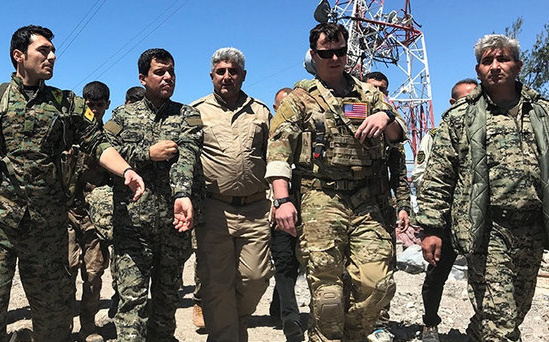US commander with colleagues of the Kurdish militia YPG in northeast Syria, April 2017
The US military claims a resumption of military operations alongside the Kurdish-led Syrian Democratic Forces, after a breakdown of several weeks because of Donald Trump’s acceptance of Turkish control of northeast Syria.
American military officials said missions against the Islamic State in the northeast were renewed on Friday. US troops and hundreds of SDF fighters sought to kill and capture ISIS fighters in Deir ez-Zor Province, about 120 miles south of the Turkish border.
The US created the SDF, led by the Kurdish militia YPG, in October 2015 to remove the Islamic State from the northeast. ISIS lost its last village, near the Iraqi border, in March; about 90,000 fighters and their families are in SDF-guarded camps.
But on October 6, during a phone call with Turkish President Recep Tayyip Erdoğan, Trump agreed to Ankara’s cross-border military operations to take over a zone across the Kurdish cantons of Kobani and Cezire. Trump ordered the withdrawal of all 1,000 US troops from northern Syria.
Three days later, Turkish forces and anti-Assad fighters launched their offensive. They seized a strip of territory along the border, between the towns of Ras al-Ain and Tel Abyad.
On October 22, Erdoğan and Russian President Vladimir Putin agreed on joint military oversight of a zone 480 km (270 miles) long and 30 km (19 miles) deep, extending east across the Euphrates River to Iraq. They also confirmed Ankara’s demand for the withdrawal of the YPG militia.
The Turkish President says he wants to resettle 2 million Syrian refugees, of the 3.6 million in Turkey, in the area.
Meanwhile the Pentagon pushed back against Trump’s withdrawal order. Using the rationale of protecting Kurdish-held oilfields outside Erdoğan’s “safe zone”, they were able to maintain the deployment of several hundred US troops.
However, the US-SDF operation on Friday is well outside the Turkish-Russian zone of control, taking place 100 miles to the south.
“No End Date”
The US military said several Islamic State positions were attacked, with the killing or wounding “multiple” ISIS fighters and the capture of more than a dozen.
“What we’re talking about are the pockets of people who represent the wreckage that followed in the wake of the [ISIS] caliphate,” General Kenneth McKenzie, the commander of US Central Command,. “They still have the power to injure, still have the power to cause violence.”
Last week the Defense Intelligence Agency, continuing the pushback against Trump, said the Islamic State — despite the killing of its leader Abu Bakr al-Baghdadi in an American raid last month — would likely use American withdrawal to regroup in Syria and bolster the capacity for attacks beyond the country.
McKenzie maintained that relations with the Kurds-led SDF were “pretty good” despite Trump’s abandonment last month. Asked how long US troops would remain in the northeast, he replied, “We don’t have an end date.”
Turkey Pressure on NATO
Turkey is reportedly exerting pressure on NATO to back Ankara’s control of the “safe zone” across mainly-Kurdish areas.
“Four senior alliance sources” say Ankara is refusing to support a defense plan for the Baltic States and Poland until NATO promises its support over Syria.
One claimed, “They are taking eastern Europeans hostage, blocking approval of this military planning until they get concessions.”
A second source said Turkish behavior is “disruptive”.
The plan for the defense of Lithuania, Latvia, Estonia, and Poland was drafted at their request after Russia annexed Crimea from Ukraine in 2014. Security documents are scheduled to be approved at a summit next week.
Turkey called for NATO’s support, in Erdoğan’s fight against the “terrorist” YPG, before the October offensive.
Ankara considers the YPG to be part of the Turkish Kurdish insurgency PKK, which has fought Turkey’s security forces for 35 years.

